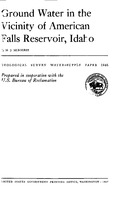Analysis of ground- and surface-water relationships suggests that increasing
the capacity of the American Falls Reservoir by raising the height of the
dam 15 feet would increase leakage from the reservoir by less than 0.2 percent
of the average inflow to the reservoir, or less than 10,000 acre feet per year.
This amount is less than one-tenth of the evaporation rate from the reservoir.
The American Falls Reservoir lies near the south margin of the Snake
River Plain in southeastern Idaho. The Snake River Plain is about 200 miles
long and averages nearly 60 miles in width. It is underlain by a thick sequence
of basaltic lava flows, interbedded pyroclasties, and sedimentary deposits. The
uppermost few thousand feet of this sequence is the Snake Plain aquifer, one of
the great aquifers of the United States.
Recharge to the aquifer is chiefly by water percolating from the Snake River, its
tributaries, and irrigated tracts, and by underflow from surrounding areas.
Ground water moves generally southwestward and discharges to the Snake River
through springs in the American Falls Reservoir reach and in the Hagerman
Valley reach (between Twin Falls and Bliss). Total discharge from the aquifer
is about 9,000 cfs (cubic feet per second).
The occurrence and movement of ground water in the viscinity of American
Falls Reservoir are controlled by the local geology. Silt and tuff in the Neeley
Formation and the Walcott Tuff and silt and fine sand in the FT ft Formation
and American Falls Lake Beds have a low permeability. These rocks transmit
little ground water compared with the basalt and intercalated pyroclasties and
gravels of the Snake Plain aquifer. The less permeable deposits underlie the
reservoir area and act as a barrier to the movement of ground water.
Under present conditions the water table on the periphery of the reservoir
slopes toward the reservoir, except within 3 or 4 miles of the dam, where the
water table slopes away from the reservoir. Most of the springs discharge at
altitudes above 4,370 feet, some 15 feet above the maximum reservoir stage.
Thus, reservoir stage has little effect on ground-water inflow to the reservoir.
A fairly close relationship exists between the annual amount of surface water
diverted for irrigation of lands up the Snake River from the reservoir and the
annual ground-water discharge through springs for the period 1911-60. After
about 1952, greatly increased ground-water withdrawals from wells, which increased
consumptive use, virtually balanced increased diversions from the surface-
water system for irrigation, so that ground-water inflow to the reservoir
remained about constant.


